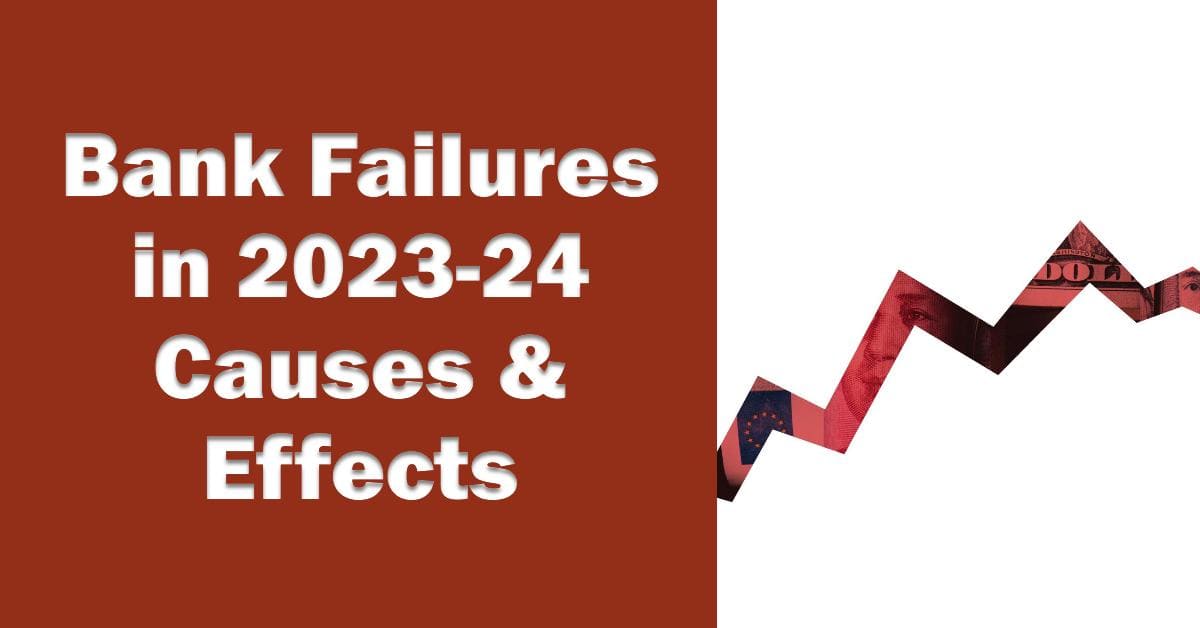The banking sector in the United States has witnessed a series of bank failures from 2023 to 2024, events that have stirred discussions and concerns among investors, customers, and regulators alike. This blog post aims to provide an informational overview of the recent bank failures, their implications, and the measures taken by regulatory bodies to manage these situations.
Recent Bank Failures in 2023 and 2024
The Wave of Bank Failures in 2023
The year 2023 saw a total of five bank failures, a number that is considered low compared to historical data. However, the size and circumstances of these failures were significant. The collapse of Silicon Valley Bank (SVB) on March 10, 2023, followed by Signature Bank on March 12, and First Republic Bank on May 1, marked some of the largest bank failures in US history.
These institutions primarily served wealthy customers and startups, with a considerable portion of deposits exceeding the FDIC insurance limit of $250,000.
Following the collapse of these larger banks, two smaller regional banks also failed: Heartland Tri-State Bank in July and Citizens Bank of Sac City in November 2023. These failures highlighted the vulnerabilities of smaller institutions in a challenging economic environment. Here are the recent bank failures in 2023 as listed by FDIC.
The Lone Bank Failure of 2024
As of late April 2024, there has been only one bank failure: Republic First Bank. This suggests a relative stabilization in the banking sector, although it is important to remain vigilant as economic conditions evolve.
List of Recently Failed Banks from 2019-2024
| Failed banks | Date closed |
|---|---|
| Republic First Bank | April 26, 2024 |
| Failed banks | Date closed |
|---|---|
| Citizens Bank, Sac City, IA | November 3, 2023 |
| Heartland Tri-State Bank, Elkhart, KS | July 28, 2023 |
| First Republic Bank, San Francisco, CA | May 1, 2023 |
| Signature Bank, New York, NY | March 12, 2023 |
| Silicon Valley Bank, Santa Clara, CA | March 10, 2023 |
| Failed banks | Date closed |
|---|---|
| Almena State Bank, Almena, Kan. | 10/23/2020 |
| First City Bank of Florida, Fort Walton Beach, Fla. | 10/16/2020 |
| The First State Bank, Barboursville, W.Va. | 04/03/2020 |
| Ericson State Bank, Ericson, Neb. | 02/14/2020 |
| Failed banks | Date closed |
|---|---|
| City National Bank of New Jersey, Newark | 11/1/2019 |
| Resolute Bank, Maumee, Ohio | 10/25/2019 |
| Louisa Community Bank, Louisa, Ky. | 10/25/2019 |
| The Enloe State Bank, Cooper, Texas | 05/31/2019 |
Causes of Recent Bank Failures in the U.S.
The recent spate of bank failures in the United States from 2023 to 2024 has been attributed to a confluence of factors that have put considerable stress on financial institutions.
Here's an exploration of the primary causes that led to the collapse of these banks:
Commercial Real Estate Loans and Interest Rate Hikes
A significant factor contributing to the bank failures was the exposure to commercial real estate loans coupled with the impact of rising interest rates. Many banks, especially smaller ones with assets under $10 billion, faced the dual threat of potential losses from these loans and the broader economic effects of higher interest rates. These conditions created a precarious situation where the value of the banks' assets could rapidly decline, leaving them vulnerable to insolvency.
Withdrawals and Underwater Bond Portfolios
Another critical issue was the mass withdrawal of deposits by customers, particularly at regional banks like Silicon Valley Bank and Signature Bank. Many of these customers were tech or crypto businesses that needed liquidity to cover losses or found better savings rates elsewhere. This situation was exacerbated by the fact that raised interest rates had already weakened the banks' balance sheets, reducing the value of their holdings in government bonds.
Regulatory Challenges and Risk Management
Regulatory oversights and failures in risk management also played a role. Some banks were unable to navigate the complex regulatory environment effectively or manage the risks associated with their investment and loan portfolios. This led to a lack of preparedness for the economic shifts that occurred, resulting in their eventual collapse.
The Role of Uninsured Deposits
A high proportion of uninsured deposits also contributed to the banks' vulnerability. When banks hold a significant amount of deposits that exceed the FDIC insurance limit, they risk losing the confidence of their depositors, which can trigger bank runs and lead to failure.
Economic and Market Instability
The broader economic and market instability also cannot be overlooked. Fluctuations in the market, changes in monetary policy, and economic downturns can all create an environment where banks are more likely to fail. The banks that collapsed were, in many cases, not prepared to withstand such economic pressures.
In summary, the collapse of these banks was not due to a single cause but rather a combination of several interconnected factors that affected their stability and solvency. It serves as a reminder of the importance of prudent risk management, regulatory compliance, and economic resilience in the banking sector.
ALSO READ: Which Banks Are in Danger of Failing or Collapse?
Regulatory Actions Being Taken to Prevent Bank Failures
Regulators have been proactive in implementing a series of measures aimed at preventing future collapses and ensuring the stability of the financial system. These measures are designed to address the various factors that contributed to the failures and to strengthen the resilience of banks against potential economic shocks. Here is an overview of the regulatory actions being taken:
Enhancing Capital Requirements
One of the primary measures is the enhancement of capital requirements for banks. Capital acts as a buffer against losses, and by increasing the minimum capital requirements, regulators aim to ensure that banks have a stronger financial foundation. This move is expected to help banks absorb unexpected shocks and reduce the likelihood of failure.
Stricter Risk Management Guidelines
Regulators have also implemented stricter risk management guidelines, including stress testing and enhanced risk assessment methodologies. These guidelines require banks to identify, measure, and manage risks in a proactive and comprehensive manner. By doing so, banks can detect potential vulnerabilities early and take corrective actions before they escalate into systemic risks.
Improving Transparency and Disclosure
Improving transparency and disclosure requirements is another critical step taken by regulators. Banks are now required to disclose more detailed information about their operations and financial positions. This increased transparency allows investors, regulators, and the public to make informed decisions and assess a bank's financial health more accurately, thereby reducing the likelihood of hidden risks and failures.
Regular Assessments and Reforms
Regulators are conducting regular assessments of the regulatory measures and their impact on bank stability. These assessments help identify gaps and inform necessary reforms. By embracing a proactive approach to regulatory oversight, regulators can stay ahead of potential threats and prevent future bank failures.
Addressing the Issue of Uninsured Deposits
The issue of uninsured deposits has also been addressed, with regulators considering policy options related to deposit insurance coverage levels, excess deposit insurance, and the implications for risk-based pricing and deposit insurance fund adequacy.
Reversing Regulatory Rollbacks
There have been calls for reversing the 2018 regulatory rollbacks that lifted certain prudential requirements for midsize banks. Reinstating these requirements would help ensure that banks are better equipped to handle financial pressures and maintain stability.
Comprehensive Reviews and Investigations
The Federal Reserve and the Federal Deposit Insurance Corporation (FDIC) are conducting comprehensive reviews and investigations to understand the causes of the recent failures and to determine what actions can be taken to prevent similar occurrences in the future. These reviews are crucial for developing a deeper understanding of the crisis and for formulating effective preventive strategies.
The combination of these measures reflects a concerted effort by regulators to fortify the banking sector and protect it from future crises. While the effectiveness of these actions will be tested over time, they represent important steps toward a more robust and secure financial system.
The Impact of US Bank Failures on the Economy: Perspective
The series of bank failures in the United States during 2023 and 2024 has had a notable impact on the economy, with repercussions that extend beyond the banking sector.
Immediate Economic Repercussions
The immediate aftermath of the bank failures saw a ripple effect across financial markets. Investor confidence was shaken, leading to a drop in stock prices and an increase in market volatility. The failures of significant players like Silicon Valley Bank and Signature Bank caused particular concern due to their roles in financing tech and startup ecosystems, which are vital for innovation and economic growth.
Credit Availability and Business Operations
Credit availability tightened as a result of the bank failures. Banks became more cautious in their lending practices, which made it harder for businesses, especially small and medium-sized enterprises, to access the funds they needed to operate and expand. This credit squeeze could potentially slow down economic growth and lead to a reduction in job creation.
Consumer Confidence and Spending
Consumer confidence took a hit as news of the bank failures spread. Concerns about the safety of deposits, even though largely unfounded due to FDIC insurance, led to a more conservative approach to spending. Reduced consumer spending can have a dampening effect on economic growth since it accounts for a significant portion of economic activity.
Regulatory and Policy Implications
The bank failures prompted a swift response from regulators and policymakers. Measures to enhance the stability of the financial system were introduced, including stricter capital requirements and risk management protocols. While these measures are designed to prevent future failures, they also lead to increased compliance costs for banks, which could be passed on to consumers and businesses in the form of higher fees and interest rates.
Long-Term Economic Outlook
In the long term, the bank failures may lead to a restructuring of the banking industry, with a possible consolidation of smaller banks and a reevaluation of business models that rely heavily on specific sectors or customer bases. This consolidation could lead to a more resilient banking sector, but it also raises concerns about reduced competition and its impact on consumers.
Global Economic Considerations
The US bank failures also have global implications. As the world's largest economy, the stability of the US banking system is crucial for international financial markets. The failures could lead to a reassessment of risk by global investors and affect the flow of capital worldwide, with potential impacts on foreign exchange rates, international trade, and global economic stability.




